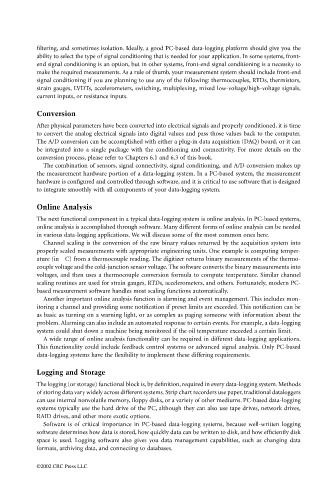Page 1228 - The Mechatronics Handbook
P. 1228
filtering, and sometimes isolation. Ideally, a good PC-based data-logging platform should give you the
ability to select the type of signal conditioning that is needed for your application. In some systems, front-
end signal conditioning is an option, but in other systems, front-end signal conditioning is a necessity to
make the required measurements. As a rule of thumb, your measurement system should include front-end
signal conditioning if you are planning to use any of the following: thermocouples, RTDs, thermistors,
strain gauges, LVDTs, accelerometers, switching, multiplexing, mixed low-voltage/high-voltage signals,
current inputs, or resistance inputs.
Conversion
After physical parameters have been converted into electrical signals and properly conditioned, it is time
to convert the analog electrical signals into digital values and pass those values back to the computer.
The A/D conversion can be accomplished with either a plug-in data acquisition (DAQ) board, or it can
be integrated into a single package with the conditioning and connectivity. For more details on the
conversion process, please refer to Chapters 6.1 and 6.3 of this book.
The combination of sensors, signal connectivity, signal conditioning, and A/D conversion makes up
the measurement hardware portion of a data-logging system. In a PC-based system, the measurement
hardware is configured and controlled through software, and it is critical to use software that is designed
to integrate smoothly with all components of your data-logging system.
Online Analysis
The next functional component in a typical data-logging system is online analysis. In PC-based systems,
online analysis is accomplished through software. Many different forms of online analysis can be needed
in various data-logging applications. We will discuss some of the most common ones here.
Channel scaling is the conversion of the raw binary values returned by the acquisition system into
properly scaled measurements with appropriate engineering units. One example is computing temper-
ature (in ∞C) from a thermocouple reading. The digitizer returns binary measurements of the thermo-
couple voltage and the cold-junction sensor voltage. The software converts the binary measurements into
voltages, and then uses a thermocouple conversion formula to compute temperature. Similar channel
scaling routines are used for strain gauges, RTDs, accelerometers, and others. Fortunately, modern PC-
based measurement software handles most scaling functions automatically.
Another important online analysis function is alarming and event management. This includes mon-
itoring a channel and providing some notification if preset limits are exceeded. This notification can be
as basic as turning on a warning light, or as complex as paging someone with information about the
problem. Alarming can also include an automated response to certain events. For example, a data-logging
system could shut down a machine being monitored if the oil temperature exceeded a certain limit.
A wide range of online analysis functionality can be required in different data-logging applications.
This functionality could include feedback control systems or advanced signal analysis. Only PC-based
data-logging systems have the flexibility to implement these differing requirements.
Logging and Storage
The logging (or storage) functional block is, by definition, required in every data-logging system. Methods
of storing data vary widely across different systems. Strip chart recorders use paper, traditional dataloggers
can use internal nonvolatile memory, floppy disks, or a variety of other mediums. PC-based data-logging
systems typically use the hard drive of the PC, although they can also use tape drives, network drives,
RAID drives, and other more exotic options.
Software is of critical importance in PC-based data-logging systems, because well-written logging
software determines how data is stored, how quickly data can be written to disk, and how efficiently disk
space is used. Logging software also gives you data management capabilities, such as changing data
formats, archiving data, and connecting to databases.
©2002 CRC Press LLC

